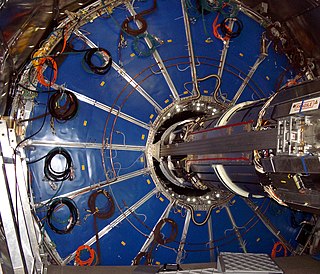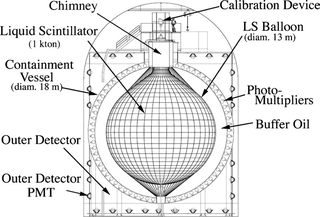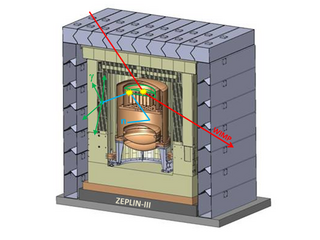
Argon is a chemical element with the symbol Ar and atomic number 18. It is in group 18 of the periodic table and is a noble gas. Argon is the third-most abundant gas in Earth's atmosphere, at 0.934%. It is more than twice as abundant as water vapor, 23 times as abundant as carbon dioxide, and more than 500 times as abundant as neon. Argon is the most abundant noble gas in Earth's crust, comprising 0.00015% of the crust.
Weakly interacting massive particles (WIMPs) are hypothetical particles that are one of the proposed candidates for dark matter.

In physics, a time projection chamber (TPC) is a type of particle detector that uses a combination of electric fields and magnetic fields together with a sensitive volume of gas or liquid to perform a three-dimensional reconstruction of a particle trajectory or interaction.

The Kamioka Liquid Scintillator Antineutrino Detector (KamLAND) is an electron antineutrino detector at the Kamioka Observatory, an underground neutrino detection facility in Hida, Gifu, Japan. The device is situated in a drift mine shaft in the old KamiokaNDE cavity in the Japanese Alps. The site is surrounded by 53 Japanese commercial nuclear reactors. Nuclear reactors produce electron antineutrinos () during the decay of radioactive fission products in the nuclear fuel. Like the intensity of light from a light bulb or a distant star, the isotropically-emitted flux decreases at 1/R2 per increasing distance R from the reactor. The device is sensitive up to an estimated 25% of antineutrinos from nuclear reactors that exceed the threshold energy of 1.8 megaelectronvolts (MeV) and thus produces a signal in the detector.
The XENON dark matter research project, operated at the Italian Gran Sasso National Laboratory, is a deep underground detector facility featuring increasingly ambitious experiments aiming to detect hypothetical dark matter particles. The experiments aim to detect particles in the form of weakly interacting massive particles (WIMPs) by looking for rare nuclear recoil interactions in a liquid xenon target chamber. The current detector consists of a dual phase time projection chamber (TPC).

SNOLAB is a Canadian underground science laboratory specializing in neutrino and dark matter physics. Located 2 km below the surface in Vale's Creighton nickel mine near Sudbury, Ontario, SNOLAB is an expansion of the existing facilities constructed for the original Sudbury Neutrino Observatory (SNO) solar neutrino experiment.
The ArDM Experiment was a particle physics experiment based on a liquid argon detector, aiming at measuring signals from WIMPs, which may constitute the Dark Matter in the universe. Elastic scattering of WIMPs from argon nuclei is measurable by observing free electrons from ionization and photons from scintillation, which are produced by the recoiling nucleus interacting with neighbouring atoms. The ionization and scintillation signals can be measured with dedicated readout techniques, which constituted a fundamental part of the detector.

DEAP is a direct dark matter search experiment which uses liquid argon as a target material. DEAP utilizes background discrimination based on the characteristic scintillation pulse-shape of argon. A first-generation detector (DEAP-1) with a 7 kg target mass was operated at Queen's University to test the performance of pulse-shape discrimination at low recoil energies in liquid argon. DEAP-1 was then moved to SNOLAB, 2 km below Earth's surface, in October 2007 and collected data into 2011.

The Large Underground Xenon experiment (LUX) aimed to directly detect weakly interacting massive particle (WIMP) dark matter interactions with ordinary matter on Earth. Despite the wealth of (gravitational) evidence supporting the existence of non-baryonic dark matter in the Universe, dark matter particles in our galaxy have never been directly detected in an experiment. LUX utilized a 370 kg liquid xenon detection mass in a time-projection chamber (TPC) to identify individual particle interactions, searching for faint dark matter interactions with unprecedented sensitivity.
The DAMA/LIBRA experiment is a particle detector experiment designed to detect dark matter using the direct detection approach, by using a matrix of NaI(Tl) scintillation detectors to detect dark matter particles in the galactic halo. The experiment aims to find an annual modulation of the number of detection events, caused by the variation of the velocity of the detector relative to the dark matter halo as the Earth orbits the Sun. It is located underground at the Laboratori Nazionali del Gran Sasso in Italy.

The European Underground Rare Event Calorimeter Array (EURECA) is a planned dark matter search experiment using cryogenic detectors and an absorber mass of up to 1 tonne. The project will be built in the Modane Underground Laboratory and will bring together researchers working on the CRESST and EDELWEISS experiments.

EDELWEISS is a dark matter search experiment located at the Modane Underground Laboratory in France. The experiment uses cryogenic detectors, measuring both the phonon and ionization signals produced by particle interactions in germanium crystals. This technique allows nuclear recoils events to be distinguished from electron recoil events.
The DarkSide collaboration is an international affiliation of universities and labs seeking to directly detect dark matter in the form of weakly interacting massive particles (WIMPs). The collaboration is planning, building and operating a series of liquid argon time projection chambers (TPCs) that are employed at the Gran Sasso National Laboratory in Assergi, Italy. The detectors are filled with liquid argon from underground sources in order to exclude the radioactive isotope 39
Ar, which makes up one in every 1015 (quadrillion) atoms in atmospheric argon. The Darkside-10 (DS-10) prototype was tested in 2012, and the Darkside-50 (DS-50) experiment has been operating since 2013. Darkside-20k (DS-20k) with 20 tonnes of liquid argon is being planned as of 2019.

The ZEPLIN-III dark matter experiment attempted to detect galactic WIMPs using a 12 kg liquid xenon target. It operated from 2006 to 2011 at the Boulby Underground Laboratory in Loftus, North Yorkshire. This was the last in a series of xenon-based experiments in the ZEPLIN programme pursued originally by the UK Dark Matter Collaboration (UKDMC). The ZEPLIN-III project was led by Imperial College London and also included the Rutherford Appleton Laboratory and the University of Edinburgh in the UK, as well as LIP-Coimbra in Portugal and ITEP-Moscow in Russia. It ruled out cross-sections for elastic scattering of WIMPs off nucleons above 3.9 × 10−8 pb from the two science runs conducted at Boulby.
The Particle and Astrophysical Xenon Detector, or PandaX, is a dark matter detection experiment at China Jinping Underground Laboratory (CJPL) in Sichuan, China. The experiment occupies the deepest underground laboratory in the world, and is among the largest of its kind.

Elena Aprile is an Italian-American experimental particle physicist. She has been a professor of physics at Columbia University since 1986. She is the founder and spokesperson of the XENON Dark Matter Experiment. Aprile is well known for her work with noble liquid detectors and for her contributions to particle astrophysics in the search for dark matter.

The LUX-ZEPLIN (LZ) Experiment is a next-generation dark matter direct detection experiment hoping to observe weakly interacting massive particles (WIMP) scatters on nuclei. It was formed in 2012 by combining the LUX and ZEPLIN groups. It is currently a collaboration of 30 institutes in the US, UK, Portugal and South Korea. The experiment is located at the Sanford Underground Research Facility (SURF) in South Dakota, and is managed by DOE's Lawrence Berkeley National Lab.
Laura Baudis (1969) is a Romanian-born German particle astrophysicist. She is employed as a full professor by the University of Zurich, Switzerland. Her research focuses on dark matter and neutrino physics. She is a member of the science strategy team for XENON as well as the CERN Scientific Policy Committee (2016–18) and the PSI Research Committee for Particle Physics.

ANAIS(Annual modulation with NaI Scintillators) is a dark matter direct detection experiment located at the Canfranc Underground Laboratory (LSC), in Spain.
Direct detection of dark matter is the science of attempting to directly measure dark matter collisions in Earth-based experiments. Modern astrophysical measurements, such as from the Cosmic Microwave Background, strongly indicate that 85% of the matter content of the universe is unaccounted for. Although the existence of dark matter is widely believed, what form it takes or its precise properties has never been determined. There are three main avenues of research to detect dark matter: attempts to make dark matter in accelerators, indirect detection of dark matter annihilation, and direct detection of dark matter in terrestrial labs. The founding principle of direct dark matter detection is that since dark matter is known to exist in the local universe, as the Earth, Solar System, and the Milky Way Galaxy carve out a path through the universe they must intercept dark matter, regardless of what form it takes.












